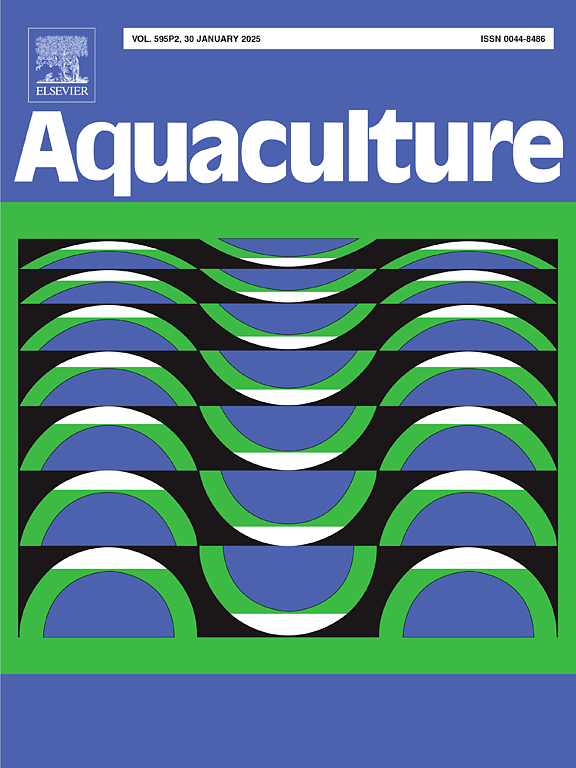Exploring cryomedium with hypotonic extender for sturgeon sperm cryopreservation
IF 3.9
1区 农林科学
Q1 FISHERIES
引用次数: 0
Abstract
This study investigates sperm cryopreservation across multiple sturgeon species (sterlet, Siberian, Russian, and stellate sturgeons), testing different cryomedia and two cryopreservation formats: small 0.5 ml plastic straws, rapidly cooled on a polystyrene raft within a Styrofoam box, and larger 4.5 ml and 10 ml cryotubes subjected to a controlled, slow cooling process in a programmable freezer. The cryomedia tested included a novel hypotonic (relative to the osmolality of seminal plasma) extender containing 1 mM KCl, methanol, and ethylene glycol at varying concentrations, alongside traditional cryomedium. The study assessed the impact of cryomedia on spermatozoa volume changes during the equilibration period, fertilization success, and embryogenesis. Notably, the cryoprotectants ethylene glycol and methanol affected sperm cell volume differently: ethylene glycol caused initial shrinkage, followed by volume normalization, whereas methanol did not induce significant changes in spermatozoa volume. Key findings demonstrated that a cryomedium with a hypotonic extender containing 1 mM KCl, 11 % methanol, and 2.5 % ethylene glycol effectively preserved post-thaw sperm motility, achieving 46 ± 6 % in both 0.5 ml straws and 4.5 ml cryotubes for Siberian sturgeon; 31 ± 10 % in 0.5 ml straws and 40 ± 12 % in 10 ml cryotubes for Russian sturgeon; and 46 ± 10 % in 0.5 ml straws, 39 ± 8 % in 4.5 ml cryotubes, and 44 ± 11 % in 10 ml cryotubes for Stellate sturgeon. The cryomedium also supported high embryo development and hatching rates, with Siberian sturgeon achieving 81 ± 16 % and 79 ± 15 % in 0.5 ml straws, and 84 ± 6 % and 82 ± 7 % in 4.5 ml cryotubes. For Russian sturgeon, development and hatching rates were 60 ± 20 % and 57 ± 20 % in 0.5 ml straws, 51 ± 12 % and 48 ± 13 % in 4.5 ml cryotubes, and 62 ± 11 % and 48 ± 13 % in 10 ml cryotubes. These results highlight the effectiveness of this alternative cryopreservation approach across different sturgeon species and sample volumes. However, spermatozoa from cryopreserved samples with the 1 mM KCl extender showed a statistically significant reduction in curvilinear velocity (VCL) compared to fresh sperm and spermatozoa cryopreserved in traditional cryomedia. Nevertheless, fertilization success was not affected, and no significant morphological abnormalities were observed in the resulting embryos. This study introduces an alternative cryopreservation protocol for sturgeon species, demonstrating the feasibility of using cryomedium with 1 mM KCl extender and large sample volumes (4.5 ml and 10 ml cryotubes) without compromising fertilization outcomes. The findings contribute to advancing cryopreservation techniques, offering promising new possibilities for sturgeon aquaculture and conservation.
求助全文
约1分钟内获得全文
求助全文
来源期刊

Aquaculture
农林科学-海洋与淡水生物学
CiteScore
8.60
自引率
17.80%
发文量
1246
审稿时长
56 days
期刊介绍:
Aquaculture is an international journal for the exploration, improvement and management of all freshwater and marine food resources. It publishes novel and innovative research of world-wide interest on farming of aquatic organisms, which includes finfish, mollusks, crustaceans and aquatic plants for human consumption. Research on ornamentals is not a focus of the Journal. Aquaculture only publishes papers with a clear relevance to improving aquaculture practices or a potential application.
 求助内容:
求助内容: 应助结果提醒方式:
应助结果提醒方式:


